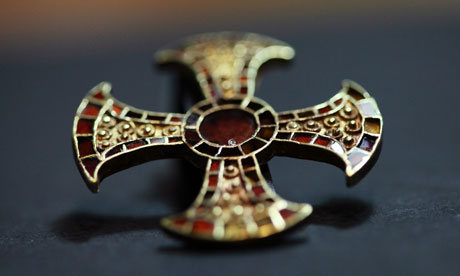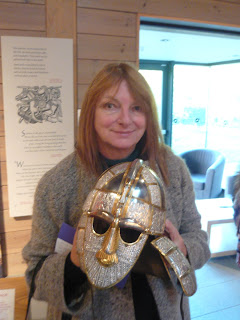An interesting late seventh century Anglo-Saxon burial was, only last week, unearthed in Trumpington, a village near Cambridge. This early Saxon burial was that of a noble young lady and it is unusual in that her funeral involved a bed burial. Not many bed burials have been found. Yes, she was laid out on a bed, probably her own. As centuries fled past, the wood rotted away leaving only the iron bed brackets. However, an exquisite pectoral gold cross was discovered in her grave and this beautiful object has survived. Its discovery has led me, yet again, to consider the beauty of Anglo-Saxon crafts.

Making clay moulds
Brooches and crosses were generally crafted using a mould. First a pattern was made in the form of the casting needed. The pattern was then dusted with soot or stone dust to stop the clay adhering when the pattern was pressed into a pad of soft clay. The back of the object was moulded first so as to avoid damage to the casting during later work. The clay could not overlap the edges of the pattern as the pattern needed to be removed from the mould. The mould dried and hardened and was dusted again before a second pad of clay was modelled against the first. This second pad formed the impression for the face of the object, for instance a cross or a brooch. As the clay began to harden yet again the two halves of the mould were separated and the pattern removed. Metal was carefully poured into the mould. The two halves of the mould were then placed together and fully dried ready for baking and use. Wax was another method used for moulds and was an easier material to work with. However, to a degree, if this process was used at the period of the bed burial, it is mostly a lost process because the use of wax results in the destruction of both the mould and pattern. We know that this wax process was favoured for bell casting.

Soldering the Objects
Gold objects were usually fabricated. Component parts of objects were soldered together. Soldering lamps have been found during excavations at Coppergate in York. They are thought to have contained beef fat and a wick; air was blown through a mouth-pipe onto a flame. This gave intense directed heat that was used in soldering precious and non-ferrous alloys.

Inlay and Decoration
One of the chief glories of Anglo-Saxon craftsmanship was garnet inlay. Intricate and interlocking red stones were animated by the corrugated gold foil that lay between them. The Anglo-Saxons were also skilled at working wire and making glass, also used for decoration. Garnets were popular stones in Anglo-Saxon jewellery work as they were found in rocks and alluvial deposits throughout Europe. It is thought that Anglo-Saxon garnets travelled from as far away as Sri-Lanka and certainly from Bohemia. In cloisonne work, the garnets were formed into thin plates which were then cut into geometric shapes and placed in cells often forming lattice-like designs. Gold cloisonne cells were soldered to a base-plate and to each other. That was only one of the techniques early medievals used. There were others such as setting gold into garnet.

I am always amazed by the delicacy and intricate craftsmanship of Anglo-Saxon metal work, the brooches, the decoration on swords and helmets and the sometimes flashy but generally gorgeous jewellery worn by men and women of rank. It is an aspect of late Anglo-Saxon life that I have incorporated into my writing of fiction set in the eleventh century and one which I have spent many hours pondering in the British Museum where there is a collection of exquisite early medieval objects extremely well displayed. When I visit the museum I feel closer to their world.

And, of course, we must not forget the Sutton Hoo Helmet. If men were buried with ships, helmets and swords during the long ago years of the seventh century, were, indeed, noble women occasionally buried with their beds as well as those lovely precious objects that reflected their earthly lives?
Have you ever found an object from the past? I would love to know.
Further Reading
The Blackwell Encyclopedia of Anglo-Saxon England edited by Michael Lapidge, John Blair, Simon Keynes and Donald Scragg
Anglo-Saxon Crafts by Kevin Leahy




